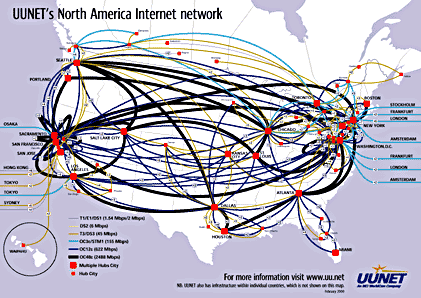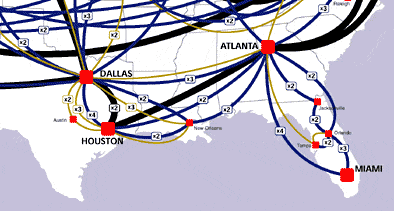 |
|
|
||||||||||||||||||||||||||||||||||||||||
|
Maps to Market Your Network Maps have long been a powerful tool of the marketing men. Maps of networks - be they networks of canals, railroads, roads or airlines - have been repeatedly employed in the service of promotion and persuasion [1]. Networks are all about connecting together distant places with dedicated links to speed the flow of goods and people between them. Networks are all too often in competition with each other and therefore need marketers to demonstrate to potential customers that one particular network is superior, in that it interconnects more places and offers greater capacity (in form of speed or frequency links). Today, some of the most important networks in our daily lives carry pulses of light rather than bulky goods and people, and are largely hidden from view being underground and beneath the oceans. The networks are built of glass rather than concrete and steel, using high-capacity fibre-optic cables to carry huge volumes of digital data, which contain our phone conversations, emails, mp3s and web pages, including the one you are reading. The big corporations that build and operate these data networks use maps to market their power of connectivity and capacity. In this article I want to look at just one exemplar of these maps, those produced by UUNET [2]. UUNET is one of the world's leading Internet network providers, part of the massive MCI WorldCom corporation. There are many other interesting maps from other Internet companies, but we don't have time to cover them in detail here (see sidebar for listing).
Above is an example of UUNET's network maps, showing the impressive capacity and connectivity the company offers in North America, as of February 2000. This map is part of a series, with a global overview one as well as detailed maps for the European and Asia-Pacific regions [3]. They are created by Henry Ritson, UUNET's global marketing manager. Ritson actually studied geography at Cambridge University, but he is motivated more by the power of the maps as marketing tools rather than cartographic pursuit itself. As he said in a recent email interview for Mappa.Mundi, "The network maps are a critical sales tool for us - throughout the world - so I am producing maps by virtue of their global importance - not my geographical background." The maps are updated on a quarterly basis using information on network infrastructure from the engineering department. The information is turned into high-quality, hand-crafted maps, a time consuming cartographic exercise taking several days work for each map. It is important to realise that the maps are an abstraction from reality, they summarise much of the messy complexity of network infrastructure in ordered looking maps. Also, the maps can only capture the state of UUNET's network at a single snap-shot in time. In the frenetic world of Internet infrastructure provision UUNET's network is growing at a thousand percent a year and links and nodes are added and upgraded all the time. Ritson's acknowledges the limits, "The map can go significantly out of date in a week. It is a terrifying moving target." The engineers who design, build and maintain the network can obviously track the infrastructure but the maps and schematics they use for this task are full of highly technical and confidential information, so are not suitable for the public.
The cartographic design of Ritson's marketing maps uses the conventional arc-node topology to represent the network on a geographic base. In this way, UUNET's maps have much in common with the black and white ARPANET maps (see my article "ARPANET (October, 1980)", Map of the Month June 1, 1999), but obviously the capacity of network is orders of magnitude greater. The figure above is part of the map, showing greater detail for Southeast USA. In the map links between cities are shown by lines, where colour and thickness encode capacity measured in Mbps. The thin gold coloured lines are 45 Mbps T3s and the range goes up to thick black lines which are the 12 lane superhighways of the Net carrying a massive 2,488 Mbps. Where there are multiple links over the same route they are labelled with little boxes, saying x3 (times three links). For example between Atlanta and Miami there are four 622Mbps links. The key hub cities of UUNET's network in this part of the USA, shown by the large red squares, are in Atlanta, Dallas, Houston and Miami. It is clear from this map that UUNET has developed an extensive, high-capacity, network forming a dense mesh of links connecting most metropolitan areas of the USA. Indeed, the density of network capacity in Silicon Valley and along the Washington-Boston corridor are pushing the bounds of cartographic legibility on the map as links crowd together in limited geographic space. Ritson is very clear on the value of the maps in UUNET's marketing efforts. The maps, along with details on Points-of-Presence around the world and measurement of network performance [4], provide 'hard-facts' that can make the UUNET's network more tangible to potential customers, thereby helping to demonstrate the superiority of UUNET's network over competitors. In this respect, the use of real-world geography provides an important, familiar template on which to draw the network topology. Ritson argues, "... ultimately, the Gibsonesque virtual world is only an illusion. The network is actually made up of large pieces of glass fibre. There are very un-virtual people out there digging up roads, and sailing across the Pacific in large cable laying boats to make it happen." I would certainly concur with this view, I firmly believe that geography still matters and is a key framework in understanding the shape of the Internet (but then I am biased, being a geographer by profession!). Given his grounding in real-world geography, surprisingly Ritson says his 'dream' map of the Internet, drawing very much on William Gibson's cyberspace vision [5], would be an immersive VR version of one of the massive 'Whole Internet' graphs produced by Bill Cheswick and Hal Burch [6]. One could walk into and through this 'map' seamlessly highlighting different aspects of the network. Lastly, he added, "I would also like to wear those shades like in The Matrix while I am in there ;-)" Now, this would be a cool map to market your network. Copyright © 1999, 2000 media.org. |
|||||||||||||||||||||||||||||||||||||||||
|






